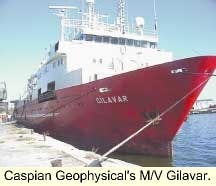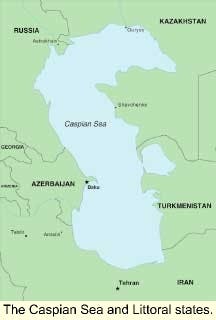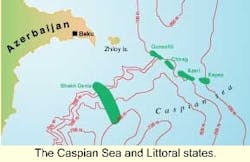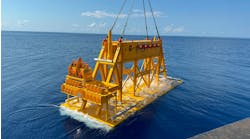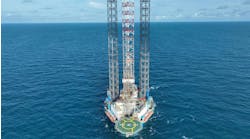MIDEAST/CASPIAN SEA: Caspian exploration scaling up; vessel buildup needed to cut costs
Exploration in the Caspian Sea is fraught with difficulty. Operating costs are high, the geology is complex, and the climate is inclement much of the year. As if that weren't deterrent enough, the region surrounding the Caspian could serve as a textbook example of political instability. Yet, the Caspian is attracting more and more companies in search of purportedly world-class reserves that total an estimated $4 trillion.
Exploration in the area offshore Azerbaijan, primarily carried out through agreements with the State Oil Company of Azerbaijan (Socar), has turned up some spectacular plays. The largest play to date in the Azeri sector is the Azeri-Chirag field, onstream since 1997 with estimated recoverable reserves of 4.6 billion bbl.
The promise of this field has kept interest high in the area. And since activity began on the Shakh Deniz prospect, 70 km southwest of Azeri-Chirag, the Caspian has become a magnet for investors.
Renewed interest
Even companies that previously pulled out of the area are showing interest again. In May of last year, Conoco re-entered the region by acquiring a 20% interest in the Zafar Marshal exploration block. The block is in the high-potential Volga Delta play in the South Caspian basin, which has yielded several proven discoveries. Socar will retain a 50% interest in the block, which will be operated by ExxonMobil (30% interest).
Socar is optimistic about the potential of its holdings in the Caspian Sea. The Turan newsletter quotes Khoshbakht Yusifzade, Vice President of Socar, enumerating the plus side of the Caspian market:
- Projected levels of investment totaling over $90 billion for regional development projects
- Signing of final agreement for construction and financing of the Baku-Tbilisi-Ceyhan pipeline
- Acceleration of full field development of Azeri Chirag Gunashli (ACG) with tenders for construction companies, subcontractors and supply companies (Ramco announced agreement to sell its 2.08% carried interest in the ACG fields offshore Azerbaijan, Amer-ada Hess acquired 1.04%; Devon Energy acquired 0.81%; and Unocal acquired 0.23% in late December 2000).
- Exceptional production results from Chirag-1 with oil extraction from the Chirag field to be increased to 7.5 million tons a year from 2002 to 2005.
- BP's plans to upgrade existing Soviet pipeline and to construct a new pipeline to transport reserves of gas from Shakh Deniz to Turkey via Georgia by 2002 or early 2003
- Natural gas from the Absheron block expected to exceed those found within the word-class Shakh Deniz gas field.
- Socar forecasts hydrocarbon extraction will rise to 200 million tons in the next 15-20 years.
Russia/Azerbaijan cooperation
In January 2001, Russia's LUKoil opened discussions with the Azerbaijan government in order to expand its ventures in the Caspian Sea. Company President Vagit Alekperov reported that the talks with Socar address exploration rights to three deepwater blocks (D-8, D-10, and D-11) in the southern Caspian Sea located in depths of about 700 meters. LUKoil has also expressed interest in the Karabakh offshore field, which will be ready for production in about three years. - Shakh Denis and Azeri-Chirag fields.
LUKoil has already invested about $500 million in Azerbaijan projects and is one of many companies vying for projects in the Caspian Sea. The time is ripe for reaping the benefits of a new agreement between Russia and Azerbaijan for dividing the Caspian's mineral resources along national borders while sharing the water resources.
Iran - a new frontier
Caspian Sea optimism seems to have rubbed off on neighboring states, including Iran, which represents a new frontier in the Caspian Sea. The country has joined the other littoral states in the search for reserves and is courting foreign investors in what is a mostly untouched province.
While neighbors actively pursued foreign exploration and production investment in the past, Iran held back, waiting to establish a formal agreement regarding offshore holdings. In the first quarter of 2000, Iran moved off the fence and into the water with the approval of a project for National Iranian Oil Company (NIOC) to begin exploration efforts along the northern coast.
In January of 2001, the elusive official agreement came closer to becoming a reality. Iranian President Mohammad Khatami again sent out a call for the states surrounding the Caspian to sketch a settlement on the legal status of the region. A special envoy to Turkmenistan returned with concurrence from Turkmen President Saparmurat Niyazov on the Caspian Sea Status.
Iran has repeatedly said it would agree to equal use of the Caspian's oil rich deposits, which will enable it to take control of 20% of the Caspian Sea resources.
Preliminary seismic studies show that Iran's portion of the Caspian holds about 10 billion bbl of oil, with about 2.5 million bbl recoverable. Although development efforts have not yet begun, the deputy head of NIOC Mehdi Mir-Moezzi said Iran will tender for a semisubmersible to drill this portion of the Caspian.
As NIOC began its search for a driller, Tracer Petroleum Corporation entered into an agreement through a new Iranian subsidiary, Tracer Iran Trade & Finance Ltd. (TITF), to form a joint venture to move products into and out of Iran and to participate in and/or finance major industrial projects in Iran.
Under the terms of this new agreement, the business activities of the joint venture will include, but not be limited to the following:
- Buying, selling, trading, and marketing crude oil and petroleum products, including "swaps" involving countries in the Persian Gulf and Caspian Sea regions
- Financing pipeline, refinery, gas treatment, LNG, and other petroleum downstream projects in Iran.
Expecting to begin business activities promptly, the new joint venture set up an office immediately in Tehran. The profits from the business activities of the joint venture will be split on a 60/40 basis in favor of TITF.
Turkmenistan's Lam Field
Last June, Dragon Oil was awarded a 25-year production sharing contract for the Ceheleken Contract Area in the eastern Caspian Sea. And in January of this year, the company announced that it had begun drilling the first of three planned wells on the Lam Field. The first well targets reserves in the Red Series formation, which were proven, but not developed, by the previous operator. Oil is anticipated from a depth of about 2,000 meters to the proposed total depth of about 4,300 meters. The oil will be processed through the existing infrastructure.
Following Lam 22-101, Dragon intends to drill a further two wells in this initial development program. Lam 22 has the scope for six new wells if the results of the initial wells justify further drilling. Dragon believes there is significant potential in the Cheleken Block, where proven and probable reserves were independently certified as being about 600 million bbl of oil and 2.2 tcf of gas.
Lam 22-101 is the first well to be drilled on the block since the late 1980s and is also the first well ever drilled in the area using conventional western drilling technology. Ian Baron, Chief Executive of Dragon Oil, said this was an important stage in Dragon's development. "Turkmenistan has an attractive investment climate and is a good place for us to operate."
Dragon Oil's improvements to Lam's produc-tion include a wireline intervention program. Production has upped the daily average from the 17 producing wells to about 7,500 bbl. Dragon has been exporting its share of this production since mid-1998 through a swap deal with Iran. The company plans to export all future produc-tion through a new 10-year swap agreement signed in April 2000 and intends to upgrade the system as necessary to increase capacity.
With Dragon Oil committed to the region, Turkmenistan is trying to attract more operators by offering 32 additional offshore blocks covering 76,000 sq km.
Kazakhstan in the game
Kazakhstan has seen less than the lion's share of offshore exploration and production activity. Even so, the country isn't completely out of the game. Following drilling of the first well on the massive Kashagan structure in the Caspian Sea by the Offshore Kazakhstan International Operating Company (OKIOC), Kazakh-stan President Nursultan Nazarbayev, boasted that it is the largest discovery in the country, if not the world.
Of course, unverified statements issued by all of the governments in the littoral Caspian states should be viewed with a degree of skepticism. With the real estate not yet clearly divided, all of the players want to be viewed by the others as negotiating from a position of strength, and overstatement of potential reserves gives the proper illusion for heavy-handed international dealing.
However, having cautioned against blind acceptance, there is reason to believe that this claim is not without merit. Certainly, it has raised interest in the area. Kazakhstan appeals to foreign investors, and a number of significant players intend to get involved. Some of the world's largest players are already getting into the race, with TotalFinaElf maneuvering for majority holder in the consortium that will develop the area. Chevron is planning to spend $3 billion over the next four years drilling wells in the Tengiz Field and developing processing facilities.
Equipment availability
The Caspian Sea holds enough potential to serve as impetus for changing the face of exploration equipment. Two companies, in particular, have invested considerably in projects designed specifically for use in the Caspian Sea.
Transocean Sedco Forex designed the harsh-environment jackup, Trident 20, exclusively to drill in the Caspian. The rig can work in 350 ft of water, has large spud cans to manage the risk of punch-through on the soft sea floor, and can operate in -10° C. It is the only jackup operating in the Caspian Sea, in great part because of the logistical labyrinth that had to be negotiated in order for all of the parts of the rig to make their way into the area.
Building this jackup partially in the Keppel FELS shipyard in Singapore and partially in the newly established Caspian Shipyard Company in Baku, Transocean Sedco Forex coordinated a mammoth effort to transport pieces of the rig into the Caspian Sea from half-way around the world. The sections, built in Singapore, were shipped by heavy lift vessel to Mariopal in the Ukraine, where they were then transferred through the Don/Volga canal to Astrakhan and then to Baku. The pieces traversed 7,300 miles en route to the Caspian Shipyard Company, where the final build-up took place.
The cost involved in transport could be small in the face of the profit the company expects to see from the rig. The jackup will work in areas where it is economically prohibitive to operate a semisubmersible. Transocean believes it was worthwhile to build the jackup for use exclusively in this area because of long-term possibilities in what it considers to be one of the hottest new frontiers for crude oil exploration.
Spar platform hull
A second company making significant development investments in fabrication facilities and platform designs for the purpose of exploring the Caspian Sea's hydrocarbon resources is Aker Maritime. In April of last year, Aker Maritime launched the "pipe spar" concept with use in the Caspian in mind. Nicknamed "Caspar," the spar platform hull, which is formed from a series of pipes, is designed for use in depths of up to 1,000 meters in the Caspian Sea.
The Caspar could well open up a new phase of development in the Caspian Sea. Semisub-mersibles, which are already in widespread use in the Caspian, could be upgraded to operate at depths up to about 500 meters. The spar-based structure will provide new options already proven in the Gulf of Mexico. The new design will be built with both drilling and production facilities. Readiness to begin construction is likely to be within this year.
Seismic surveying
In July 1999, Schlumberger acquired a majority interest in Caspian Geophys-ical, a major provider of marine seismic acquisition services in the Caspian Sea. Located in Baku, the company, a joint venture with Socar, continues to operate under the trade name of Caspian Geophysical.
Although the company already owned the M/V Baki, an efficient 3D vessel operating in the Caspian, the decision was made to outfit a second seismic vessel. The new joint-venture company transferred the Geco Gamma, which had eight-streamer capability and was equipped with the latest acquisition technologies, from the North Sea to the Caspian in order to outfit it to survey the Caspian Sea.
Getting the vessel into the Caspian Sea via the narrow, shallow Volga-Don Canal necessitated radical modification in Istanbul, Turkey, and complete de-rigging of the vessel, followed by a complicated re-build when it reached its destination.
In September 1999, the vessel, renamed M/V Gilavar, was refitted with in-sea equipment, including proprietary monowing technology, which enables very wide streamer separation for efficient 3D acquisition. In October, M/V Gilavar began shooting 3D seismic for BP Amoco in the Azerbaijan sector of the Caspian. In December 2000, Caspian Geophysical began the second phase of the ultra-deep non-exclusive seismic survey. The M/V Gilavar, towing an 8 km streamer, recorded a 1,500-km 2D survey recording data down to 40 km.
Although there has been significant investment on the part of Caspian Geophysical, there has also been profit. Since 1994, Caspian Geophysical has been authorized by Socar with exclusive rights to perform non-exclusive 2D seismic data acquisition, processing, and licensing. The company has 45,000 km of non-exclusive 2D seismic data available for license.
Pipeline competition
The move is on to create the necessary infrastructure to pipe the oil and gas that is expected to result from planned exploration. In late January, Iran announced the completion of an oil pipeline that is expected to carry 50,000 b/d from the Caspian Sea coast, the port of Neka, to the Tehran Oil Refinery. NIOC says the second phase of the project will be constructed by March of next year. Iran's plan is to provide the most economical route for transferring Caspian oil and gas to Europe.
Meanwhile, former US Secretary of Energy Bill Richardson announced that the ink is dry on the final signatures needed to approve the Baku-Ceyhan pipeline. The pipeline, which will run from the Azerbaijan capital of Baku to Ceyhan, Turkey, is projected to be complete by 2004-2005.
In Kazakhstan, the Caspian Pipeline Consor-tium (CPC) has laid new pipe to connect the Tengiz Field to the Russian Black Sea port of Novorossiysk. The 935-mile pipeline project is expected to be operational by the mid-year with an initial capacity of 560,000 b/d and will support increased production.

